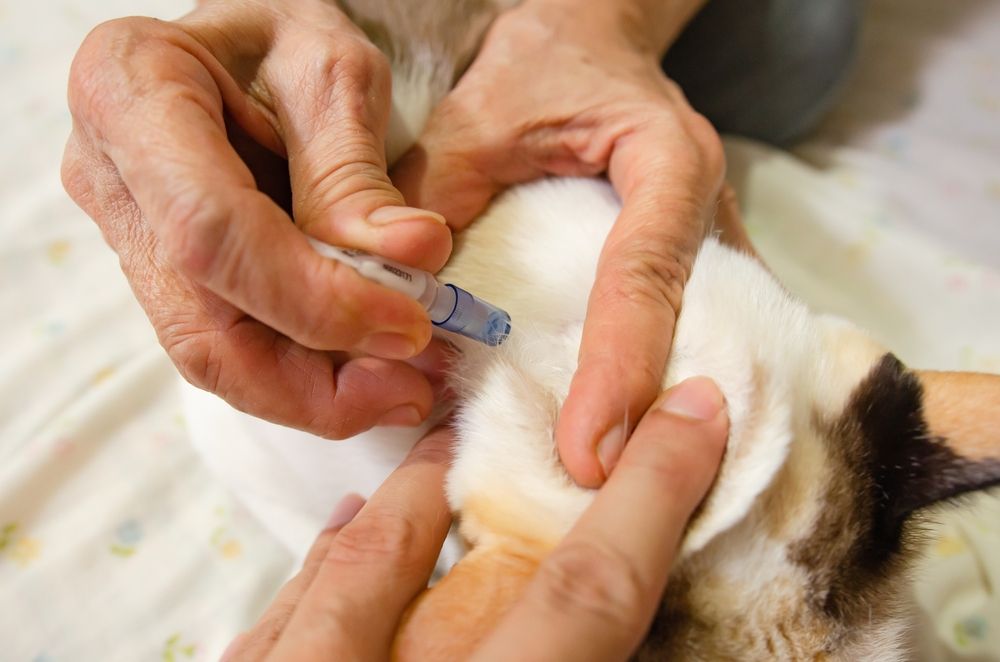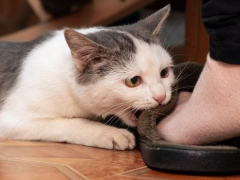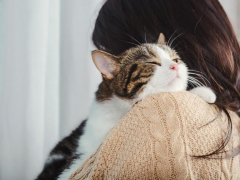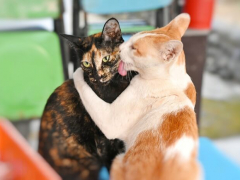
Maren Winter / Shutterstock.com
Miliary dermatitis in cats is a pattern of skin disease, rather than a condition in itself. It’s a specific cutaneous (skin) reaction that occurs in response to multiple skin conditions such as allergies or parasites. There are various symptoms to watch out for with this skin condition, along with different treatments available from your veterinarian, depending on the underlying cause.
In this article, we’ll discuss everything that you need to know about miliary dermatitis in cats including the common causes, signs to watch out for, and the treatments available.
Causes of Miliary Dermatitis in Cats
Miliary dermatitis isn’t a disease, but a type of common skin reaction that cats can get. Cats usually get this reaction in response to an allergy, but it can be associated with other skin conditions. The most common cause of miliary dermatitis is flea bite hypersensitivity or flea allergy dermatitis. Cats can be extremely sensitive to flea bites and it doesn’t necessarily take a lot of fleas to cause a reaction.
Apart from fleas, cats can get miliary dermatitis in response to other allergens and skin conditions too. These include:
- Food allergies
- Environmental allergies e.g. dust mites
- Skin parasites e.g. mites
- Bacterial infection
- Fungal infection (dermatophytosis) e.g. ringworm
- Contact allergy (rare)
Cats with underlying hormonal problems or poor diets may also show signs of skin problems, which can present as miliary dermatitis in some cases.
Symptoms of Miliary Dermatitis
The name miliary dermatitis comes from the latin word ‘milium’ for millet seeds. This is because miliary dermatitis commonly causes small crusty scabs, which mimic little seeds. These scabs are the main symptom of miliary dermatitis, and you may be able to feel them while petting or grooming your cat. It might be difficult to see them unless your cat has hair loss associated with their skin reaction. Miliary dermatitis lesions are usually present on the head, neck and extending down the spine to the tail base. They can also be present on the flanks and belly.
Common clinical signs of miliary dermatitis in cats include:
- Small crusty scabs
- Itching (pruritus)
- Hairless areas (alopecia)
- Hair pulling
- Thickened skin
- Twitching skin
It can occur in combination with other skin reactions such as eosinophillic granuloma complex, which causes eosinophillic plaques or indolent ulcers.
Complications of Having Miliary Dermatitis
Cats with miliary dermatitis may also present with a secondary skin infection. This may be due to the skin condition itself or caused by self-trauma from scratching. Signs of a skin infection include scabs with pustules (white heads), skin that is looking raw and red, or has a discharge.
Skin infections will require additional treatment along with the treatment for miliary dermatitis. Cats with severe infections may also have signs such as fever, lethargy or weight loss. These factors will make the treatment of miliary dermatitis more complicated.
Diagnosis of Miliary Dermatitis

Cats with itchy, scabby skin need a full health assessment with a veterinarian, and treatment to ease their discomfort. Pressmaster / Shutterstock.com
If you suspect that your cat may have a skin condition, schedule an appointment with your veterinarian. Your vet will take a thorough history from you including when the skin condition started, any recent food changes, recent parasite treatment and any other relevant information that you have. They will examine your cat’s skin and check for any fleas, flea dirt or other parasites such as mites.
Your vet might do further testing, such as examination to check for bacterial or fungal infections, skin scrapes, or biopsies if the cause of the miliary dermatitis isn’t clear or they suspect other conditions also. They may recommend blood testing to check for underlying conditions or flea allergy testing.
If the skin condition is complicated they may refer the case to a veterinary dermatologist who specializes in skin conditions for further investigation.
Treatments for Miliary Dermatitis
Treatment for miliary dermatitis depends on the underlying cause. In many cases, this may be a flea allergy reaction but other allergens or skin conditions may be the culprit too. Once your vet has found the cause of the dermatitis, they will likely dispense treatment to treat the underlying cause and to treat the skin reaction itself.
Treatment of the Underlying Cause
For example, if your cat has a flea bite hypersensitivity that causes miliary dermatitis your vet will give your cat a flea treatment, and discuss ongoing management. In cases of food allergies, your vet may recommend you to do a food trial. This will involve doing a novel protein or hypoallergenic food trial for at least 6 weeks.
Treatment of the Skin Reaction (Miliary Dermatitis)
Miliary dermatitis is an irritating and even painful skin condition for your cat so your vet will likely dispense medication to help your cat feel more comfortable. This may include corticosteroids for the itching, and antibiotics if there’s a secondary skin infection. Your vet may inject these or dispense oral medication for you to give your cat at home.
Other treatments that are sometimes used are antihistamines, essential fatty acids, cyclosporine (Atopica) and topical creams or mousses. The use of buster collars or cones isn’t recommended as a treatment solution without addressing and treating the underlying skin problem, but can be used in the short term under your vet’s advice.
Long Term Outcome
Once the underlying cause is addressed and the right treatment prescribed, cats will often recover from miliary dermatitis within a couple of weeks. Cats with allergies may require long term medication to control their symptoms. Miliary dermatitis is likely to reoccur if the underlying cause isn’t addressed.
Cat Care Tips
If your cat has just been diagnosed with miliary dermatitis (and hopefully the underlying cause has been found) it’s likely that you’ll be looking after them for the next couple of weeks. We have some cat care tips to help you and get your cat back to themselves and feeling comfortable.
- Stick to their medication schedule: it’s likely that your cat will be on medication from their veterinarian. Follow all the instructions and give the medication at the correct intervals. If you miss a dose or are finding it difficult to medicate your cat, contact your vet for advice. Don’t use any over the counter medications that you have at home, unless your vet has told you otherwise.
- Reduce your cat’s stress: miliary dermatitis is an uncomfortable and itchy condition for cats. Reduce your cat’s overall stress and help them feel relaxed by providing plenty of resources that are easy for them to access. Resources include food, water, beds, litter boxes, scratching posts and human company (if they want it). Plugging in synthetic pheromones can help to reduce your cat’s stress.
- Provide plenty of access to water: if your cat is on steroids for their skin condition, they may experience an increased thirst. Provide more water sources if they’re thirsty – never restrict their access to water.
Prevention of Miliary Dermatitis in Cats

Regular and effective parasite preventatives are recommended for most pet cats. tewpai dechpitak / Shutterstock.com
As we know now from this article, miliary dermatitis describes a skin condition and has many potential underlying causes. In order to help prevent miliary dermatitis from occurring, there are some things that you can do:
- Give regular veterinary prescribed flea prevention
- Feed a high quality complete cat food
- Include essential fatty acids in their diet
- Avoid sudden changes to their diet or environment
- Try to avoid allergens if possible
Your cat may still develop miliary dermatitis if you follow the guidelines above, but it will go a long way to help prevent it. Don’t forget to treat all in contact animals with parasite treatment from your veterinarian.
Regular veterinary care, vaccinations and check-ups are essential to your cat’s health. Don’t hesitate to visit your vet if you think your cat is unwell.
Also Read: Common Skin Problems in Cats: Causes and Treatments
Frequently Asked Questions
Is miliary dermatitis in cats curable?
If the miliary dermatitis is caused by parasites or an infection, it can be cured with treatment from your veterinarian. Miliary dermatitis caused by allergens may be more complex to treat and require long-term medication.
How did my cat get miliary dermatitis?
Cats can develop miliary dermatitis as a result of parasites, infections or allergies. They may have picked up parasites or an infection outside. Changes in food type or household cleaners may have caused an environmental allergy.
Can food cause miliary dermatitis in cats?
Yes cats can develop miliary dermatitis in response to a food allergy. This is particularly likely if you’ve recently changed your cat’s food.
How serious is cat dermatitis?
Dermatitis can be a serios condition as it’s uncomfortable and painful for your cat. Cats with dermatitis can develop a secondary infection which can make them feel unwell. If your cat has dermatitis, schedule an appointment with your veterinarian.
Should I take my cat to the vet for miliary dermatitis?
Yes you should always take your cat to the vet for miliary dermatitis. Your cat will likely need treatment to help with their itchy and discomfort and may need antibiotics for a secondary skin infection.











